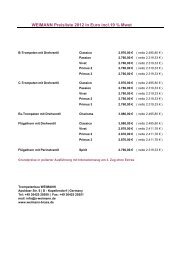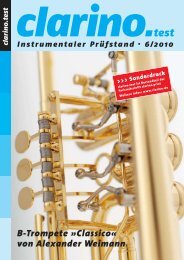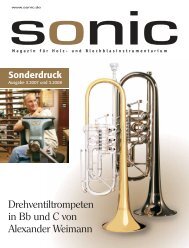Create successful ePaper yourself
Turn your PDF publications into a flip-book with our unique Google optimized e-Paper software.
trumpets in 1996, allows the especially well-balanced characteristics of the instrument<br />
when the main slide and the bell are accordingly tuned.<br />
Here, the middle register does not stand out very much from the low and high registers.<br />
The resistance is reduced through an optimized airflow in the valves. This leads to a very<br />
open blowing feel with a beautifully centred core.<br />
The cone-shaped lead pipe is inserted into a cylindrical nickel-silver tube, and thus offers<br />
the possibility to remove the lead pipe. The chosen lead pipe of 148 mm is quite long,<br />
which leads to a slight shift of weight towards the bell.<br />
“It does not feel awkward at all, as the instrument lies perfectly balanced in your hand”,<br />
says Schmelzer. There is a MINIBAL joint on the third slide and an overblow key on the<br />
tuning slide crook for C3. Water key, overblow key and trigger lever are cushioned with a<br />
cork pad, so there is no noise when pressing them.<br />
The assessment of an instrument often stands and falls with the spontaneous feel good<br />
factor. If the musician has to “struggle” with it at the beginning, it will be tough for the<br />
instrument. If the musician feels good from the very first moment, it will be the first plus.<br />
The latter is the case with the »Classico«. “The trumpet lies perfectly balanced in your<br />
hand, and from the first tones it shows its strength”, states Rainer Hauf. The instrument<br />
responds immediately to the smallest amount of air, and converts the lip vibration into<br />
tones. “This is something I have not experienced before” the tester is enthused. The<br />
response is very direct and clear, which conveys an easy and secure blowing feel. At<br />
each dynamic level the air flows freely and with little resistance through the instrument.<br />
You are never forced to push more air or to push harder. The sound remains solid and<br />
stable. “My students, who blew this instrument too, have confirmed this feeling.” The<br />
musician should never have the feeling that the instrument could let him down.<br />
The intonation leaves nothing to be desired<br />
Also where intonation is concerned the trumpet leaves nothing to be desired. You can<br />
play the instrument without spending a lot of time to get accustomed to it, and you will<br />
find all tones in exactly the right place. “That was something I liked very much, as it is<br />
often a problem with German trumpets”, Hauf sums up. Especially in the high mid-range<br />
and in the high registers this means an enormous saving of power, as you do not have to<br />
“bend” the tones. Besides that, there is no risk of slipping into another natural tone.<br />
The trumpet comes with a big and round tone. When playing piano it is stable and<br />
singing, when playing forte it is very bright and centred. “You are present without being<br />
in the foreground. In churches you can play dark tones, and for signals you can produce







